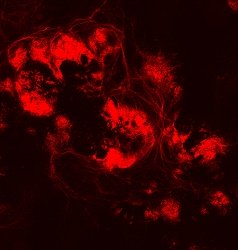«Our work could lead not only to a better understanding of the biology of the optic nerve, but also to a
 The laboratory process, described in the journal Scientific Reports, entails genetically modifying a line of human embryonic stem cells to become fluorescent upon their differentiation to retinal ganglion cells, and then using that cell line for development of new differentiation methods and characterization of the resulting cells.
The laboratory process, described in the journal Scientific Reports, entails genetically modifying a line of human embryonic stem cells to become fluorescent upon their differentiation to retinal ganglion cells, and then using that cell line for development of new differentiation methods and characterization of the resulting cells.
Using a genome editing laboratory tool called
Next, they used a technique called
Researchers also found that adding a naturally occurring plant chemical called forskolin on the first day of the process helped improve the cells’ efficiency of becoming retinal ganglion cells. The researchers caution that forskolin, which is also widely available as a weight loss and muscle building supplement and is touted as an herbal treatment for a variety of disorders, is not scientifically proven safe or effective for treatment or prevention of blindness or any other disorder.
«By the 30th day of culture, there were obvious clumps of fluorescent cells visible under the microscope," says lead author Valentin Sluch, Ph. D., a former Johns Hopkins biochemistry, cellular and molecular biology student and now a postdoctoral scholar working at Novartis, a pharmaceutical company. Sluch completed this research at Johns Hopkins before transitioning to Novartis.
«I was very excited when it first worked," Sluch says. «I just jumped up from the microscope and ran [to get a colleague]. It seems we can now isolate the cells and study them in a pure culture, which is something that wasn’t possible before.»
«We really see this as just the beginning," adds Zack. In
To use these cells to develop new treatments for MS, Zack is working with Peter Calabresi, M.D., professor of neurology and director of the Johns Hopkins Multiple Sclerosis Center.
This work was completed through the Wilmer Eye Institute’s Glaucoma Center of Excellence and its Stem Cell Ocular Regenerative Medicine Center, of which Zack is
Study
This work was supported by grants from the Maryland Stem Cell Research Fund under grant number


